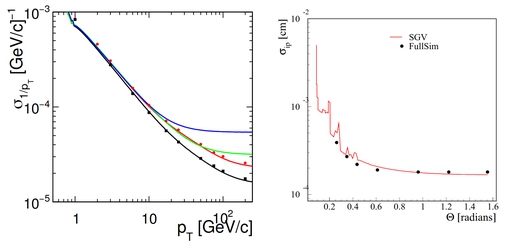Lepton Collider Physics
Research and Technologies for Future Particle Physics Experiments
Lepton Collider Physics
An electron-positron Higgs factory has been identified as the highest priority collider to follow the LHC by the European Strategy for Particle physics update in June 2020.
Four major projects that suit Higgs factory role are FCC-ee (Future Circular Collider), CLIC (The Compact Linear Collider), CEPC (Circular Electron Positron Collider) and ILC (International Linear Collider).
The SLB group persues physics studies and detector optimization for these projects, and is in particular contributing in context of the International Development Team for the ILC and of the ILD detector concept.
Time of flight for particle ID
Measurements of the time of flight of the particles at future Higgs factories can be used for the particle identification. Time of flight based particle identification can complement already existing dE/dx identification technique and contribute to the analysis of the Higgs and heavy flavour physics. This study become possible with the Low Gain Avalanche Diode (LGAD) Si sensors with the time resolution of 10-100 ps, which is enough to separate charge hadrons below 5 GeV range.
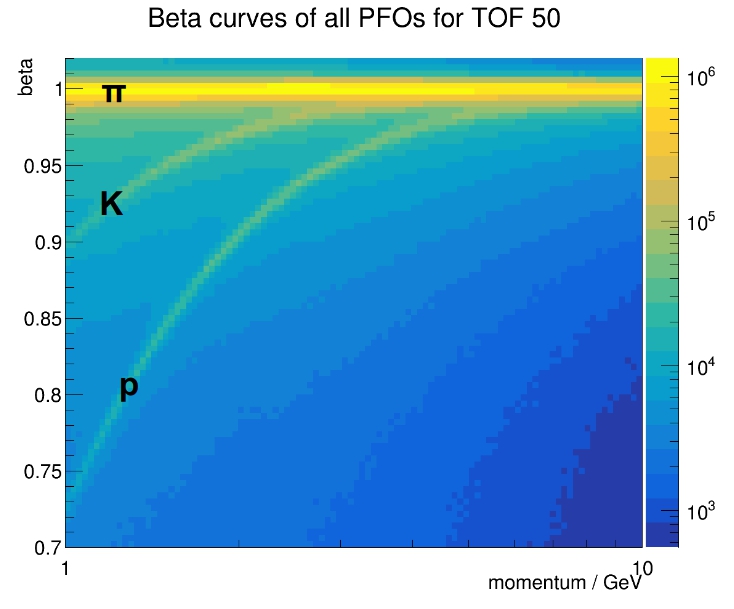
2D histogram of the velocity versus momentum. Each entry is a reconstructed particle. Three separate bands correspond to pion, kaon and proton particles.
U. Einhaus, https://arxiv.org/abs/2112.10009
Impact of the detector performance
Resolution of the reconstructed parameters such as momentum, vertex position, jet energy, etc. directly impacts further physics analyses. The detectors resolutions will depend on the final detector design. We estimate the impact of the detector performance on the interesting physics parameters such as Higgs branching ratios, etc. This information can be used to set requirements for detector performance and to optimize detector design to meet requirements for future physics analyses.
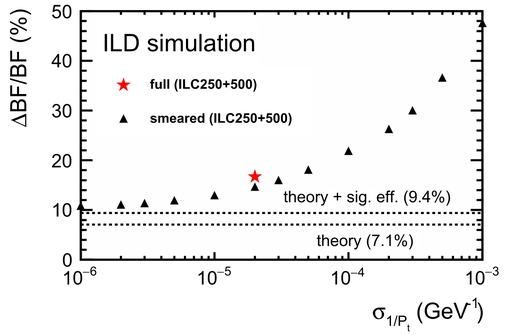
Expected precision on BF(H→μ+μ−) as a function of transverse momentum resolution σ1/Pt (triangles), together with full simulation results (star) and the theoretical limits (dashed lines) for the combination of the 2 ab−1 collected at √s=250 GeV and 4 ab−1 collected at √s=500 GeV data set
Shin-ichi Kawada, Jenny List & Mikael Berggren, https://doi.org/10.1140/epjc/s10052-020-08729-7
Impact of top-level accelerator parameters
Center-of-mass energy, luminosity and beam polarization are crucial parameter for the future Higgs factory accelerators that define acchivable regions for searches for WIMP candidates, etc. We study efects of these parameters on future physics analyses and exclusion regions for particles beyond Standard Model
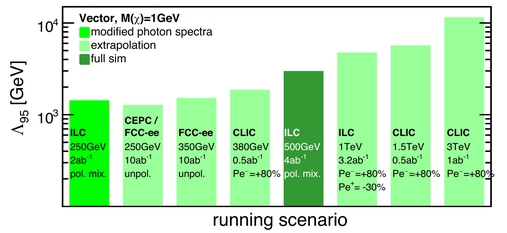
Expected sensitivities at 95% confidence level for Mχ = 1 GeV; the vector operator; and different settings for center-of-mass energy, integrated luminosity, and polarization combination.
Moritz Habermehl, Mikael Berggren, and Jenny List, https://doi.org/10.1103/PhysRevD.101.075053
Global Interpretations
The future Higgs factories provide a ground to test Supersymmetry (SUSY) and Great Unification Theories (GUT).

The running gaugino masses Mi based on the pMSSM-10 fit to ILC1 observables. The bands correspond to one standard deviation. (a) Using M3 at the weak scale as constrained from ILC measurements (b) M3 is assumed to unify with M1 and M2 and then run to the weak scale to gain a prediction for M3 (Q = 1TeV).
Howard Baer et. al., DOI:10.1103/PhysRevD.101.095026
Discovery reach for new particles
Future collider experiments have great potential for discovering new particles beyond Standard Model. Interesting candidates for new particles are light SUSY particles such as light charginos and neutralinos or scalar taus. Also the sensitivity of future colliders to extra Higgs bosons or particles from a dark sector and the resulting requirements on the detector have been or are studied in our group.
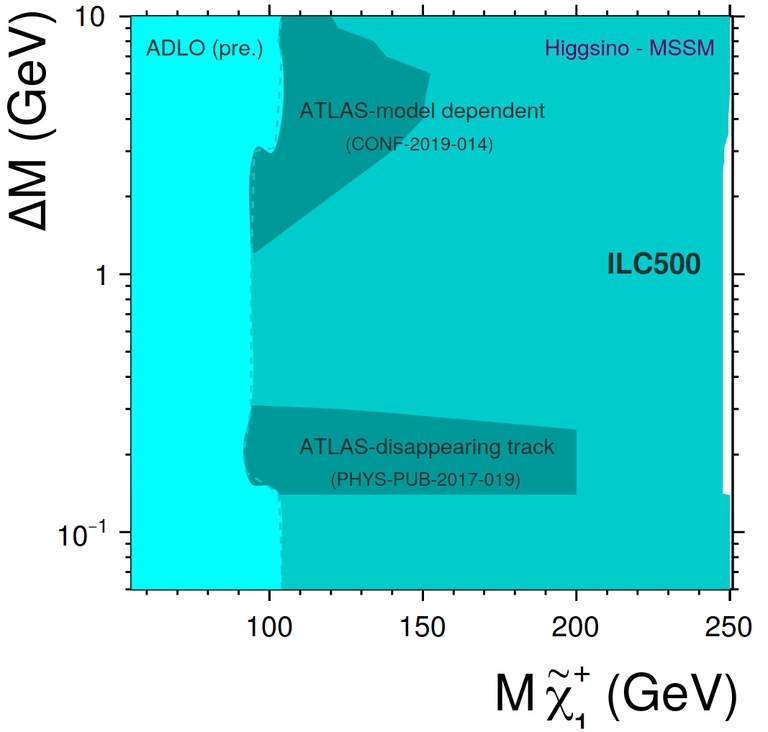
Comparison of the sensitivity reach in the plane of the difference between chargino and LSP vs the chargino mass for the case of Higgsino-like LSP for LEP, ILC500 and LHC. The LEP exclusion assumes high sfermion masses. The ATLAS results shown are model dependent and represent "best-case" exclusions.
Maria Teresa Núñez Pardo de Vera, https://arxiv.org/pdf/2012.10155.pdf
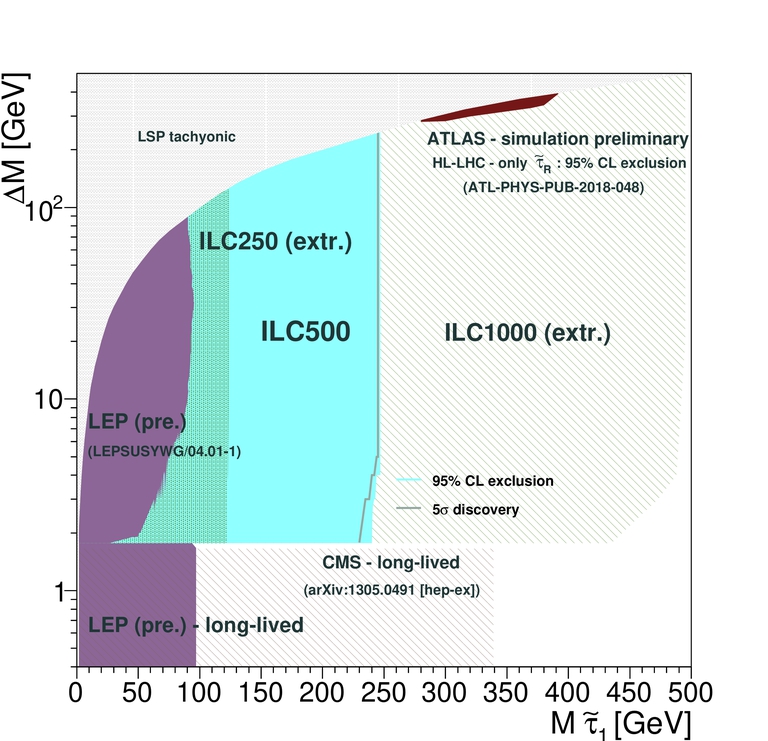
Sensitivity reach of ILC250, ILC500 and ILC 000 in the plane of mass difference between the scalar tau and the LSP vs the scalar tau mass. The region for mass differences below the mass of the scalar tau, not included in the current study, is shown for completeness. For comparison, the exclusion limits from LEP and the projected exclusion reach of HL-LHC are also show. The HL-LHC are highly model-dependent, thus the comparison has to be taken with care: Here, limits considering only pari production of scalar partners of the right-handed tau are shown, since, while still being optimistic, they are closest to the ones expected for the lightest scalar tau at the minimal cross-section. It should be noted that the HL-LHC projection is only for exclusion - no discovery potential is expected.
M.T. Núñez Pardo de Vera et al, https://arxiv.org/abs/2203.15729
High-level reconstruction: kinematic fitting
Precision of the reconstructed Higgs mass can be improved with a thorough high-level reconstruction corrections. Kinematic fitting is a mathematical tool which can improve reconstructed values resolution by fitting the measured values under constraints provided by physical laws.
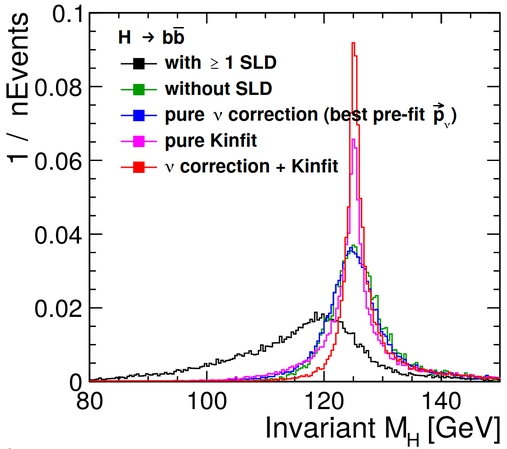
Reconstructed Higgs mass w/ and w/o applied high-level reconstruction corrections
Yasser Radkhorrami | March 16, 2021| DPG2021
Fast but precise simulation tools: SGV
High energy physics needs fast simulation programs for a quick response to new measurements and new theoretical ideas. It also would help to cope with multi-billion simulated event samples. The Simulation a Grande Vitesse (SGV) is created to adress these needs and prove fast simulation with close enough results to the full physical simulations of physics models that are time consuming.
